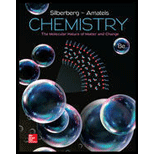
Interpretation:
For the given set of reactions in problem 20.52 the standard free energy
Concept introduction:
Enthalpy is the amount energy absorbed or released in a process.
The enthalpy change in a system
Where,
Entropy is the measure of randomness in the system. Standard entropy change in a reaction is the difference in entropy of the products and reactants.
Where,
Standard entropy change in a reaction and entropy change in the system are same.
Free energy is the term that is used to explain the total energy content in a thermodynamic system that can be converted into work. The free energy is represented by the letter G. All spontaneous process is associated with the decrease of free energy in the system. The equation given below helps us to calculate the change in free energy in a system.
Where,
Free energy (Gibbs free energy) is the term that is used to explain the total energy content in a thermodynamic system that can be converted into work. The free energy is represented by the letter
Where,
Answer to Problem 20.54P
Reaction-A the standard free energy value is
Reaction-B the standard free energy value is
Reaction-C the standard free energy value is
Explanation of Solution
Reaction-A
Given
The number of particle also decreases, indicating a decrease in entropy.
So, given reaction
Standard enthalpy change is,
The enthalpy change for the reaction is calculated as follows,
The enthalpy change is negative.
Hence, the enthalpy
Entropy change
Standard entropy change equation is,
Where,
Therefore, the
Next calculate the Free enrgy change
Standared Free energy change equation iss,
Free energy change
Calcualted enthalpy and entropy values are
These values are plugging above standard free energy equation,
Therefore, the standard free energy value is
Reaction-B
Given reaction is,
The number of particle also increases, indicating a increase in entropy.
Standard enthalpy change is,
The enthalpy change for the reaction is calculated as follows,
The enthalpy change is negative.
Hence, the enthalpy
Entropy change
Standard entropy change equation is,
Where,
Therefore, the
Next calculate the Free energy change
Standared Free energy change equation iss,
Free enrgy change
Calcualted enthalpy and entropy values are
These values are plugging above standard free energy equation,
Therefore, the standard free energy value is
Reaction-C
Given reaction is,
Standard enthalpy change is,
The enthalpy change for the reaction is calculated as follows,
The enthalpy change is positive.
Hence, the enthalpy
Entropy change
Standard entropy change equation is,
Where,
Therefore, the
Finally calculate the Free enrgy change
Standared Free energy change equation iss,
Free energy change
Calcualted enthalpy and entropy values are
These values are plugging above standard free energy equation,
Therefore, the standard free energy value is
Want to see more full solutions like this?
Chapter 20 Solutions
Chemistry: The Molecular Nature of Matter and Change
 ChemistryChemistryISBN:9781305957404Author:Steven S. Zumdahl, Susan A. Zumdahl, Donald J. DeCostePublisher:Cengage Learning
ChemistryChemistryISBN:9781305957404Author:Steven S. Zumdahl, Susan A. Zumdahl, Donald J. DeCostePublisher:Cengage Learning ChemistryChemistryISBN:9781259911156Author:Raymond Chang Dr., Jason Overby ProfessorPublisher:McGraw-Hill Education
ChemistryChemistryISBN:9781259911156Author:Raymond Chang Dr., Jason Overby ProfessorPublisher:McGraw-Hill Education Principles of Instrumental AnalysisChemistryISBN:9781305577213Author:Douglas A. Skoog, F. James Holler, Stanley R. CrouchPublisher:Cengage Learning
Principles of Instrumental AnalysisChemistryISBN:9781305577213Author:Douglas A. Skoog, F. James Holler, Stanley R. CrouchPublisher:Cengage Learning Organic ChemistryChemistryISBN:9780078021558Author:Janice Gorzynski Smith Dr.Publisher:McGraw-Hill Education
Organic ChemistryChemistryISBN:9780078021558Author:Janice Gorzynski Smith Dr.Publisher:McGraw-Hill Education Chemistry: Principles and ReactionsChemistryISBN:9781305079373Author:William L. Masterton, Cecile N. HurleyPublisher:Cengage Learning
Chemistry: Principles and ReactionsChemistryISBN:9781305079373Author:William L. Masterton, Cecile N. HurleyPublisher:Cengage Learning Elementary Principles of Chemical Processes, Bind...ChemistryISBN:9781118431221Author:Richard M. Felder, Ronald W. Rousseau, Lisa G. BullardPublisher:WILEY
Elementary Principles of Chemical Processes, Bind...ChemistryISBN:9781118431221Author:Richard M. Felder, Ronald W. Rousseau, Lisa G. BullardPublisher:WILEY





